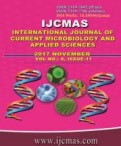


 National Academy of Agricultural Sciences (NAAS)
National Academy of Agricultural Sciences (NAAS)

|
PRINT ISSN : 2319-7692
Online ISSN : 2319-7706 Issues : 12 per year Publisher : Excellent Publishers Email : editorijcmas@gmail.com / submit@ijcmas.com Editor-in-chief: Dr.M.Prakash Index Copernicus ICV 2018: 95.39 NAAS RATING 2020: 5.38 |
Wood pulps are the starting materials for the production of paper. During the kraft pulping process, wood is cooked in sodium hydroxide and sodium sulfide, which dissolve much of the lignin present in the fibres. The residual lignin can be removed by a subsequent bleaching treatment with chlorine based chemicals. Besides chlorine, ClO2, oxygen, hydrogen peroxide, ozone and acid washing are used for bleaching the kraft pulp. However, environmental concerns lead to seek alternative ways to eliminate the use of chlorine in bleaching. White rot fungi are the most attractive candidates for the removal of residual lignin from wood pulps through biological means. Dechlorination of kraft pulp containing bound chloride compounds with crude laccase enzyme from white rot fungi is attempted in this study. In this study, the use of microbial enzymes to substitute chemical bleaching of pulp was explored. Five days old fungal cultures of P. chrysosporium and T. versicolor were inoculated into mineral salts media (N levels – 0.2% and 1%) and kept under shaking at 250 rpm, at 25-30°C. Glass marbles were added to the media to prevent fungal pellet formation which resulted in the growth of fragmented hyphal suspension. For each treatment, 100 g of pulp was taken in autoclavable polypropylens bags with cotton plugs and autoclaved at 121°C for 15 min. 10 ml of 5 days old culture suspension at different dilutions according to treatment details were inoculated into the pulp samples and incubated at room temperature (25-30°C). Pulp samples were taken at 5th and 10th day of incubation and analysed for biobleaching efficiencies. The results of the biobleaching of kraft pulps revealed that the undiluted liquid suspension culture of Phanerochaete chrysosporium and Trametes versicolor with 0.2% N (nitrogen limited conditions) efficiently degraded the lignin from all types of kraft pulps enhanced efficient bio bleaching and brightening of the kraft pulp.
 |
 |
 |
 |
 |